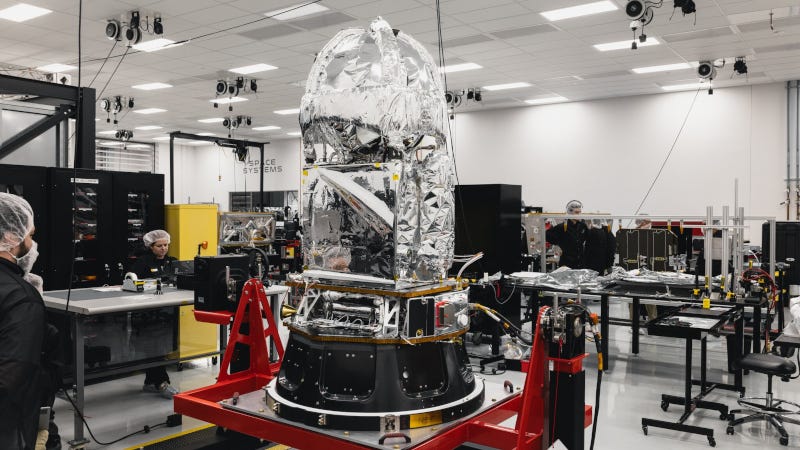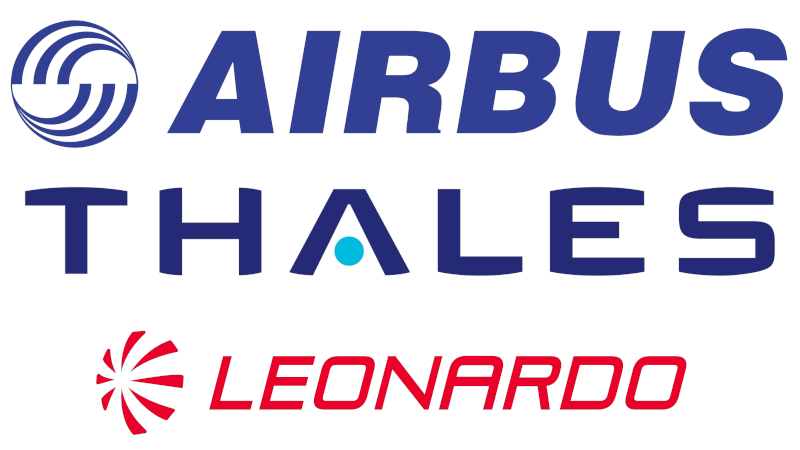The Photon spacecraft for Eta Space and NASA’s LOXSAT mission has been completed by Rocket Lab. The final piece to be cleared was the Systems Integration Review (SIR) which allows the spacecraft to proceed with payload integration. Rocket Lab will now move the mission into environmental testing – the next phase before its launch on Electron in early 2026.
LOXSAT is an on-orbit technology demonstration of a cryogenic fluid management system, that will inform the design of Cryo-Dock, a full-scale cryogenic propellant depot in low Earth orbit to be operational in 2030.
Despite being one of the most efficient and energetic propellants for spacecraft, cryogenic propellants can vaporize as temperature rises, causing critical loss on orbit. LOXSAT will test the ability to store liquid oxygen (LOX) in a zero-loss configuration, with the goal of creating a larger scale model in the future that could serve as a commercial cryogenic propellant depot in space. This would enable reuse and refueling of spacecraft on orbit.
The basis of the spacecraft is the company’s Photon platform, which gained flight heritage in 2022 with NASA’s CAPSTONE mission to the Moon.
-0-
Of course, refueling requires spacecraft to be connected via a docking mechanism. In that realm, a Letter of Intent (LOI) has been signed outlining a strategic collaboration to integrate the Enduralock OneLink docking interface into future Space Ocean platforms as a standardized in-orbit connection for fluid, data and power transfer.
As part of the agreement, Space Ocean intends to adopt Enduralock’s passive male receive port, which is available for Assembly, Integration & Test (AI&T) immediately, as a core interface across its fluid delivery and servicing ecosystem. The OneLink system enables secure transfer of power, data, and fluids, and is designed to support significant axial loads, making it a key enabler for mission-critical operations such as refueling, resource offloading and modular infrastructure support.
Enduralock, recognized for its contributions to space-qualified fasteners and advanced mechanical systems, brings a proven track record to this collaboration. The company’s OneLink system enables plug-and-play interoperability across a range of mission profiles, from orbital labs and habitats to fuel depots and cargo haulers.
The LOI is non-binding and outlines mutual objectives for technology integration, joint project evaluation and interface standardization across upcoming platforms. Discussions are also underway to explore co-development opportunities, mission-specific customization and feedback-driven enhancements.
-0-
From fuel and data transfer to inter-satellite communications, an agreement has been reached to integrate SpaceX Starlink mini laser terminals into the Muon Space high-performance Halo satellite platform.
Starlink’s mini lasers are designed to achieve link speeds of 25 Gbps at distances up to about 2,500 miles, and are capable of higher link speeds at shorter distances. By connecting to Starlink’s global satellite network, Muon will offer persistent, real-time access to their satellite constellations and data on-orbit — eliminating the latency associated with traditional ground networks and enabling real‑time tasking, payload operations, and ultra-high bandwidth data streaming to anywhere on Earth.
This agreement integrates Muon’s satellites into Starlink’s global digital infrastructure, delivering critical insights and services, and opening new business models where constellations operate with the same Internet speed and responsiveness as cloud providers and telecom networks on the ground.
Traditional ground station architectures provide brief contact windows; Starlink’s mini lasers can be easily installed into Muon Halo spacecraft, creating near‑continuous connectivity by routing traffic through SpaceX’s in‑orbit optical network to terrestrial Points of Presence.
Muon-built missions like Earth Fire Alliance’s FireSat constellation for wildfire detection and monitoring will benefit from the real-time high-bandwidth communications that Starlink provides. Incorporating mini lasers into future FireSats further enhances the global impact of this constellation on the growing wildfire and land management challenges around the world.
The United Kingdom Space Agency has awarded a Provision of Optical Delivery Partner contract to Slingshot Aerospace to expand the UK’s satellite tracking capabilities. This award strengthens the UK’s sovereign space domain awareness, expanding the Space Agency’s ability to track and characterize satellites and orbital debris.
As orbital traffic surges—about 12,000 active satellites in orbit today and 100,000 expected by 2030—maintaining a persistent, independent view of orbit is now mission-critical.
“We at Slingshot Aerospace will be delivering 13 sensor systems for the UK Space Agency and the UK National Space Operations Center across 5 global sites for them to then have a sovereign space domain awareness network,” said Dr. Mekhi Dhesi, an account executive in the international business unit at Slingshot Aerospace. “We launched our sovereign space domain awareness sensor offering earlier this year. So this is a real milestone now of us being able to deploy this sensor offering to an international customer. and being able to bring that advanced space domain awareness tracking to the UK and help them get this sovereign capability up and running.”
Slingshot will partner with Baader Planetarium to equip each site with AllSky Domes to provide environmental protection and enable resilient, autonomous, 24/7 operations across diverse conditions.
-0-
Staying on the east side of the Atlantic, a trio of space heavyweights are partnering to form a new company aiming to strengthen Europe’s strategic autonomy in space. If approved, Airbus, Leonardo and Thales will unite to enhance capabilities by combining the companies’ respective activities in satellite and space systems manufacturing and space services.
Space is a major sector that underpins critical infrastructure and services related to telecommunications, global navigation, earth observation, science, exploration and national security. This new company will bolster Europe’s space economy, and also intends to serve as a trusted partner for developing and implementing national sovereign space programs.
This new company will pool, build and develop a comprehensive portfolio of complementary technologies and end-to-end solutions, from space infrastructure to services, excluding space launchers. It will accelerate innovation in this strategic market in order to create a unified, integrated and resilient European space player, with the critical mass to compete globally and grow on the export markets.
The project is expected to unlock incremental revenues, leveraging an expanded portfolio of end-to-end products and services leading to a more competitive offering, and greater global commercial reach.
The combined entity will employ around 25,000 people across Europe. Ownership of the new company will be shared among the parent companies.
-0-
In Depth this week, there is a new space race underway. And this time, the winner will capture the economic and strategic advantages that space promises. As 2025 draws to a close, the United States confronts intensifying competition from China; a resurgent commercial space industry reshaping traditional approaches; and pressing questions about how to maintain technological superiority while managing constrained budgets and evolving geopolitical realities.
The global space economy reached an unprecedented $613 billion in 2024, according to Space Foundation, and industry analysts project it could surpass $800 billion by 2027. This explosive growth is attracting entrepreneurs, engineers, and investors who recognize that space represents not just a frontier for exploration but a critical domain for economic competitiveness, national security, and technological innovation.
America’s space infrastructure rests on three pillars: civil exploration led by NASA, national security missions coordinated by the U.S. Space Force, and an increasingly dominant commercial sector, where SpaceX has emerged as the dominant player. The government space agency is facing significant budget pressures, and Space Force is rightfully focused on national defense. Most of the exciting developments are coming from the private sector, where agility and best practices allow for much faster innovation.
Along with SpaceX, Blue Origin has been methodically building capabilities with its New Shepard suborbital vehicle and developing the New Glenn orbital rocket expected to compete directly with SpaceX for heavy-lift missions. Blue Origin is also developing the Blue Moon lunar lander and partnering with Sierra Space and Boeing on Orbital Reef, a commercial space station that received $172 million in NASA funding.
Across the Pacific, China has emerged as America’s most formidable space competitor, pursuing an integrated civil-military strategy backed by substantial state resources and long-term planning. The China Manned Space Agency announced in March 2025 that the nation is steadily advancing toward landing astronauts on the Moon before 2030, with major hardware including the Long March-10 rocket, Mengzhou spacecraft, and a lunar lander and rover all in development stages. China operates the Tiangong space station, providing continuous human presence in orbit independent of Western partnerships, and has completed successful robotic lunar sample return missions demonstrating sophisticated capabilities. Beyond exploration, China has established a network of 16 space-supporting facilities across Latin America and is building an International Lunar Research Station in partnership with Russia and other nations.
Meanwhile the European Space Agency is pursuing greater strategic autonomy and resilience, responding to geopolitical tensions and recognizing space’s critical role in European security and economic competitiveness.
Issues driving the new space race include national security imperatives and infrastructure challenges, policy recommendations, and a framework for sustained leadership.
The period from 2025 through 2035 will likely determine space leadership for the remainder of the century. NASA aims to land astronauts on the Moon through Artemis III, currently scheduled for mid-2027, and establish sustainable lunar presence enabling eventual Mars missions, though budget constraints and technical challenges create uncertainty about timelines. The cislunar economy—economic activity spanning low Earth orbit to the Moon and beyond—presents opportunities in satellite servicing, space manufacturing, resource extraction, and permanent habitats at strategic locations.
America’s space leadership faces genuine challenges from international competitors investing heavily, commercial dynamics disrupting traditional approaches, and policy debates about priorities and funding levels. The United States retains significant advantages including the world’s most innovative commercial space sector, unmatched launch capabilities, extensive ground infrastructure, experienced workforce, and integrated military-civil-intelligence space architecture. However, these advantages are not permanent and require sustained commitment, strategic vision, regulatory modernization, and the willingness to adapt legacy programs when better alternatives emerge.
You can read the full analysis on The Journal of Space Commerce under the ‘In Depth’ tab.
Worth a Second Look
Starship Development Accelerates Toward Lunar Missions
Global GPS Device Protection Now Available on a Chip
Strategic Partnership Hopes to Advance Lunar Mobility-as-a-Service
Earth Observation Market Seeing Significant Expansion: Report
U.S. Space Force Space Domain Awareness Contract Awarded to Vantor
Theme Stock Music provided by CoolTones, from Pond5

















